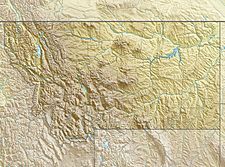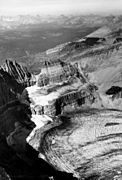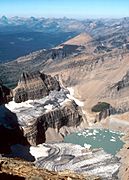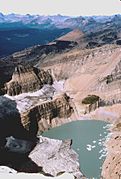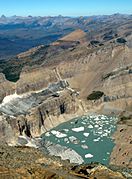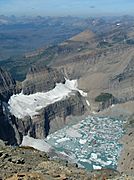Grinnell Glacier facts for kids
Quick facts for kids Grinnell Glacier |
|
|---|---|
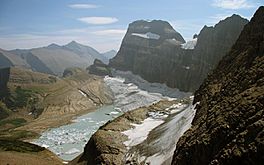
Grinnell Glacier in background (2005)
|
|
| Type | Mountain Glacier |
| Location | Glacier National Park, Glacier County, Montana, U.S. |
| Coordinates | 48°45′06″N 113°43′39″W / 48.75167°N 113.72750°W |
| Area | 152 acres (0.62 km2) in 2005 |
| Terminus | Proglacial lake |
| Status | Retreating |
Grinnell Glacier is a famous glacier located in Glacier National Park in Montana, USA. It is named after George Bird Grinnell, an early American conservationist and explorer. He worked hard to help create Glacier National Park. The glacier sits in the Lewis Range on the side of Mount Gould. It is about 7,000 feet (2,100 m) high in the Many Glacier area of the park.
Contents
The Shrinking Glacier
Grinnell Glacier has been photographed a lot since the mid-1800s. These old photos show how much the glacier has shrunk over time. In 1850, Grinnell Glacier was 710 acres (2.9 km2) big. This included an ice sheet called The Salamander Glacier, which was once connected to it. By 1993, Grinnell Glacier had shrunk to 220 acres (0.89 km2). The Salamander Glacier was then 57 acres (0.23 km2) and separate.
How Much Ice Has Been Lost?
Between 1966 and 2005, Grinnell Glacier lost almost 40 percent of its size. Scientists who study glaciers think that if carbon dioxide levels keep rising fast, all the glaciers in the park might disappear by 2030. However, if carbon dioxide levels rise more slowly, some glaciers could last until the year 2277.
Nearby Glaciers
Gem Glacier is one of the smallest glaciers left in the park. It is located above Grinnell Glacier on the Garden Wall. Pictures taken between 1938 and 2009 clearly show that Grinnell Glacier has gotten much smaller. But The Salamander and Gem Glaciers have not changed much in size during the same time. The Salamander Glacier gets its name from its shape and color. Its color comes from tiny bacteria called serratia that grow on it.
Visiting Grinnell Glacier
You can reach Grinnell Glacier by taking a 6-mile (9.7 km) hike. The trail starts at Swiftcurrent Lake. The path goes up about 1,600 ft (490 m) in height. Most of this uphill climb happens in the second half of the hike.
Grinnell Glacier Over Time
Here are some photos showing how Grinnell Glacier has changed over the years:
|


